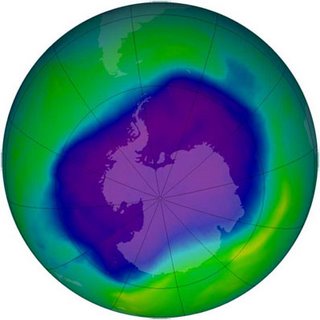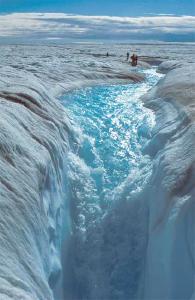 The clearest and most disturbing evidence of our global environmental impact was, and is, seen at the planet's poles. In the past week, scientists found that Antarctica's ozone hole is currently the largest on record (now bigger in area than the North American continent) while at the opposite pole researchers announced disturbing new data on the speed of Greenland's melting.
The clearest and most disturbing evidence of our global environmental impact was, and is, seen at the planet's poles. In the past week, scientists found that Antarctica's ozone hole is currently the largest on record (now bigger in area than the North American continent) while at the opposite pole researchers announced disturbing new data on the speed of Greenland's melting.
In the 1990s the world successfully addressed the ozone hole by agreeing to phase out ozone destroying chemicals. Its now a waiting game as the hole will continue to fluctuate while slowly healing over the course of the next 50 years. It is a vivid yet disturbing lesson about the time frame of planetary recovery as we continue to play Russian roullete with the world's climate by failing to act with the urgency the problem warrants.
The reasons for this are myriad, but a major one is quite literally in our view of the problem. Unlike the ozone hole we have no shared image of global warming. We see receding glaciers and drying lakes, but nothing that uniquely captures the novelty and urgency of the problem we are now facing.
In the early 1990s the world was stunned by the scientific photography of Antarctica's failing ozone cover. The idea of a future where the life giving sun became our most mortal enemy exploded into the consciousness of the world. Reports of increasing skin cancer rates became more common and citizens, businesses and governments reacted to the threat by rapidly agreeing to the phase ot of ozone depleting chemicals.
We have no such iconic image of global warming, and unfortunately, most major environmental achievements have found a place in the minds of citizens through the shocking realism of a visual image. Decimated rain forests, endangered whales and thinning ozone all have galvinized awareness and action through immediate and irrefutable proof of the problem through visual imagery - often a single shared image.
major environmental achievements have found a place in the minds of citizens through the shocking realism of a visual image. Decimated rain forests, endangered whales and thinning ozone all have galvinized awareness and action through immediate and irrefutable proof of the problem through visual imagery - often a single shared image.
This reality represents the blessing and curse of our current media reliant culture - a picture has the power to bring millions together in a common goal, but conversely, if a cause fails to offer an iconic snapshot, it will more often than not fail to create change.
This is the problem facing the leaders battling for global warming action, and the greatest ally of those who spread disinformation in the name of profit. Environmental visionaries have worked tirelessly at building consensus on the risks we all face by rising temperatures, and to their credit have made impressive progress.
Now we need our image to drive the point home.
Lưu trữ Blog
-
▼
2006
(731)
-
▼
tháng 10
(94)
- And, They're Off!
- D. Kirby
- Be Afraid!
- Al Gore to Advise UK on Climate Policy
- Global Warming Price Tag - $7 Trillion
- YouTube Video Clips Removed
- 10,000th Hit
- Is This Fair?
- Miss Cooper
- Call for legal copying of own CDs
- Australia Approves World's Largest Solar Plant
- I Count Rally Update
- Bolls
- Playlist - 28th October 2006 - Baked Goods
- Court Ruling: RIAA CAN'T Examine People's Hard Dri...
- The Coach Blog On Your Cellphone
- Green Sell Out Attacks Activist
- Toot Toot, Beep Beep, Yeah!
- Top Ten Consumers of Earth's Resources
- David Suzuki to Step Away from Spotlight
- How to Vote Green in November
- Oil Glutton to Head US Energy Policy
- British Government Tables New Climate Bill
- Why I Didn't Buy an Apple
- Carbon Neutral Oil Sands Possible
- RealClimate Offers Powerful New Search Tool
- Write to Your MP About Deep Integration
- Book A Bitch
- Skittered on the Floor
- The OC Plays Green Card
- Color Infrared
- Awesome third-party Wii controllers
- Deep Integration Update - Does Your MP Give a S#@! ?
- Brits are the EU's Worst Energy Wasters
- Made of Steel
- Our Polar Impacts
- Pics from show
- Playlist - 21st October 2006
- Absolute World
- Google Cheat Sheet (Version 1.02)
- Painting Harper's Political Corner
- Finally decided to be YOURSELF
- Zelda:Twilight Princess for GameCube NOT to be sol...
- A Departure
- Ta Da! Tory Clean Air Plan Unveiled
- Schwarzenegger Joins NE States in Global Warming F...
- Google Goes Solar
- Iceland Begins Commercial Whaling
- Its Official. There's Just Way to Many Americans
- UK Rallying Around Climate Change - Join the Effort
- Canada to Establish a New National Park
- The Black Hole: House-Hunting
- Bucs top Bengals for 1st victory
- Wal-Mart to RIAA: We're not gonna take it!
- Playlist - 14th October 2006 - Funkology
- The Big OE (Part II: Car Buying)
- Thinking of preordering a Wii from Amazon.com? Th...
- A confirmation of Nerf Wiimotes
- Tory Clean Air Act Leaked
- Oil Rich Calgary Hard Over Surging Profits
- Canada's Top CO2 Polluters Exposed
- DuPont Announces $6 Billion Sustainable Strategy
- Romance Isn't What It Use To Be
- Clean Air Pledge Goes Up in Smog
- Some Hope for First Nations Water
- Best & Worst US Elected Officials
- A Formal Affair
- Conservatives Rhetoric Announces An End Of Rhetoric
- Disney-ABC: "We understand piracy now as a busines...
- Skype Founder: Kazaa, Napster Help Music
- The Indie-Rock Insurgency Against iTunes
- BattleStar Galactica going to NBC
- She Demands
- The Big Adventure, Pt I.
- Playlist - 7th October 2006
- Car
- Feds Slammed for Failing to Protect Drinking Water
- Run Rona Run
- British Opposition Calls for Tougher Climate Laws
- George Lucas: Let's Get Small
- Tories Embarrassed as Opposition Passes Climate Bill
- Nicaragua to Saw Country in Half
- Science Idol: Winner of the UCS Cartoon Contest
- She is WoW
- News as it Should Be
- Canada Poised for CO2 Windfall - Federal Leadershi...
- US Population to Hit 300 Million
- Why CD Mastering is Ruining Music
- Save the Earth for the Cost of a Cup of Coffee
- Conservatives Given Climate Change Warning
- If you think charging for HD is OK, you are a cabl...
- It's the Great Pumpkin Porter, Charlie Brown!
- Dub Review - October 2006
- Future of Man
-
▼
tháng 10
(94)